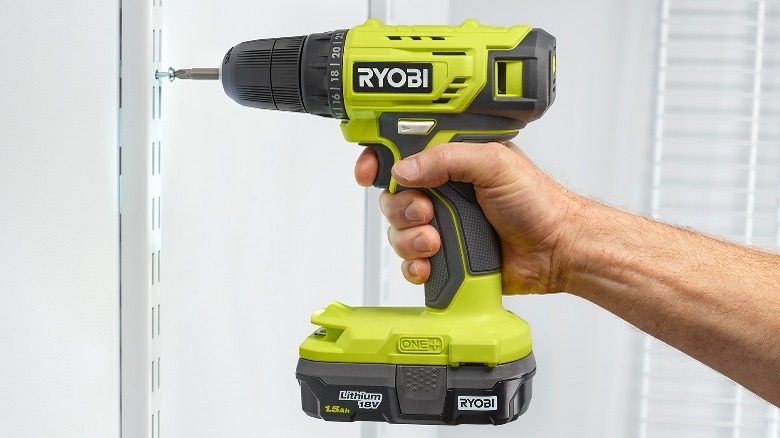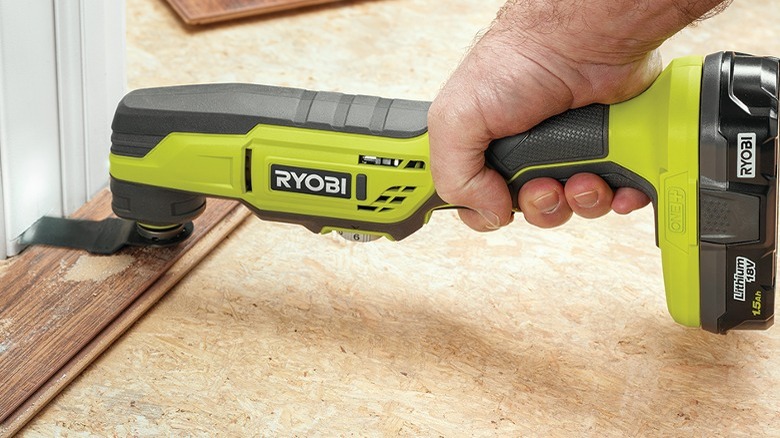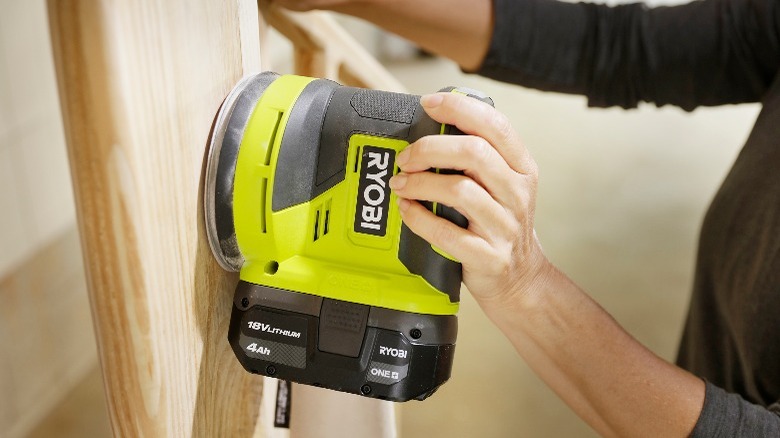5 Ryobi Tools That Could Help You Save Money On Home Repairs
Home repairs can be intimidating, and not everyone is equipped to take on every task. Technical repairs, like plumbing, electrical, and structural maintenance, should certainly be performed by a professional if you don't know what you're doing. That said, there are also a lot of smaller repairs that don't require a lot of knowledge or experience, and you could save a lot of money by taking these tasks on yourself–provided you have the right tools.
Ryobi is considered one of the best power tool brands on the market due to the affordability of its products and the quality of the goods buyers get for that price. They aren't necessarily known as the most powerful tools out there, but this price-to-performance ratio makes Ryobi an ideal choice for DIYers looking to do basic repairs without breaking the bank. The popular Home Depot-exclusive brand makes hundreds of different power tools. Some are surprisingly easy to use and can make these simple home repairs a breeze. Even if you know what kind of tool you need, there are so many varieties in Ryobi's catalog that it can be difficult to decide which is best. I've used my share of Ryobi products and performed numerous home repairs using each of these types of tools. Here are five of the best Ryobi power tools to help save you money on simple home repairs.
18V One+ ⅜-inch Drill/Driver Kit
Whether you rent or own your home, everyone should have an electric drill. It's a staple in home maintenance that's useful for everything from hanging pictures to assembling furniture. There are far too many uses for a good drill to list, but they are capable of a lot more than just making holes. You may wish to invest in a quality impact driver, too, eventually, as they deliver more force when driving fasteners, but you can get by with just a drill for most basic home maintenance and repairs.
The Ryobi 18V One+ ⅜-inch Drill/Driver Kit is a great place to start. The drill has a ⅜-inch keyless chuck, a 24-gear adjustable clutch for adjusting torque, and an LED light so you can easily see what you're working on. The kit also comes with an 18V 1.5 AH battery and charger. This powers the cordless drill and opens the door for you to use all of the other 18V tools powered by Ryobi's One+ battery system.
There are certainly several more powerful drills on the market, but I used a variation of this drill when I moved into my first apartment, and it had more than enough juice for basic home tasks like assembling furniture, drilling pilot holes, and driving fasteners into studs.
18V One+ 10-ounce Caulk and Adhesive Gun
Bathtubs, showers, sinks, windowsills, and pretty much anything else in your house designed to keep water in or out are usually sealed with some kind of caulk. This keeps water from seeping through gaps into the walls, cabinets, and floors where it can soften, rot, and mold wood. Caulk doesn't last forever, though. It can become brittle and eventually crack over time, creating pathways for water to get in. Scraping away the old caulk and replacing it is one of the simplest and most effective ways to prevent water damage in your home.
To do that, you'll need a caulk gun. Plenty of sub-$10 ones are available that require you to apply manual pressure to push out the adhesive. These are fine for small jobs, but your fingers will be killing you if you need to work for more than a few minutes.
Ryobi makes a 10-ounce Caulk and Adhesive Gun that uses its 18V One+ battery system. According to the product description, this tool can apply sealants and adhesives with up to 500 pounds of push force, and it's so energy efficient that it can dispense over 200 tubes of caulk on a single charge. The gun also has a variable speed dial, which allows you to control the discharge rate. This makes it easy for anyone to control the size of the bead as they seal their kitchens and bathrooms.
18V One+ Multi-Tool
An oscillating tool is one of those things that you don't think you'll need until you get one. Then you'll wonder how you ever got by without it. They essentially work by oscillating a saw blade back and forth to cut whatever you put in front of it. They're useful for any situation where you need to make a plunge cut or trim off a small piece of wood. I've used my oscillating tool to undercut my doorframe while installing new floors, cut out sections of damaged wall trim so I could replace it, and cut out pieces of damaged drywall to patch it. They can even cut nails if need be.
The Ryobi 18V One+ Multi-Tool is an excellent option as it is a device for both oscillation cutting and sanding. It can oscillate between 10,000-20,000 a minute using a 4.0Ah battery with the rate controlled via a variable speed dial. It also has an ergonomic rubberized grip for comfort and has a lock-on button to reduce fatigue on long jobs. The tool comes with a wood cutting blade, a segment saw, a sanding pad, and several sheets of sandpaper. It's also quite affordable, costing just over half what many other brands charge for a cordless oscillation tool.
18V One+ 6 ½-inch Circular Saw
Some home repairs require more serious cutting. There are a lot of different kinds of saws that specialize in making different kinds of cuts. Table saws are best for rip-cuts along the edge of a board, and chop saws are best for miter cuts across a board. Circular saws aren't typically as precise as either, but they're cheaper, smaller, and more versatile. You can make just about any straight-line cut with a circular saw, which makes them a great option for people who need to cut a few boards but don't necessarily want to build themselves an entire wood shop. I recently used mine to cut out a water-damaged section of my underfloor and then cut a piece of plywood to patch it. Circular saws are also good for larger carpentry projects, like cutting new wood for built-in shelves.
Ryobi makes a cordless 18V One+ 6 ½-inch Circular Saw great for most household cutting jobs. It even has a miter setting that allows you to perform angled cuts up to 55 degrees, so you can easily use it to cut trim to fit corners.
Pro Tool Reviews said, "Compared to other DIY/Prosumer-level saws, the brushless motor's torque puts Ryobi on a different level. That's not to say you can't bind the blade—you can on thicker cuts. It's just stronger than you might expect, especially if you used Ryobi's previous cordless 6 1/2-inch circular saw."
18V One+ 5-inch Random Orbit Sander
Most home improvement tasks are going to require sanding at some point. Patching a hole in the wall? You'll have to sand it. Cutting unfinished wood for a fixture? You'll have to sand it. Resurfacing a deck? You guessed it. Sand it. Sanding removes odd textures, eliminates splinters, and smoothes out rough edges. There are a few different kinds of sanders for different jobs, but a Random Orbit Sander is best for quickly and evenly smoothing out flat surfaces.
I bought Ryobi's 18V One+ 5-inch Random Orbit Sander when I first got into building my own furniture. I ended up trading it in for a more powerful DeWalt sander back when I was surfacing tabletops every weekend, but it was perfectly good for small tasks and basic home repairs.
This cordless sander produces up to 10,000 orbits per minute and promises a 40% reduction in vibration over Ryobi's previous model. That will come in handy when resurfacing large project areas. It has a hook-and-loop pad for quickly changing sandpaper and a built-in vacuum bag for easy dust collection.
That said, it does drain batteries quite quickly. Those who foresee themselves working on larger projects should probably either buy a larger battery or stick with the corded model.





